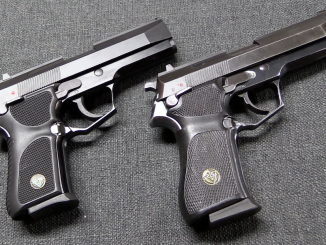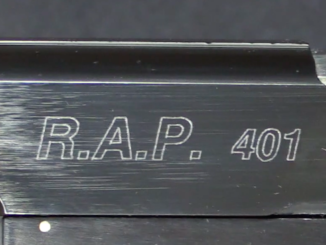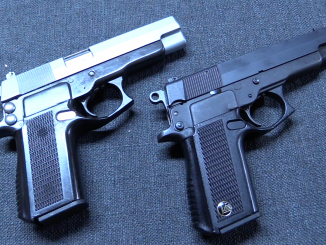Thanks to Guns.com for sponsoring today’s video! If you have a gun you are looking to sell, get an offer from them by using their simply system:
https://www.guns.com/we-buy-guns
The Vektor CP-1 was developed by Lyttleton Engineering Works (who owned the Vektor brand) in 1995 for a South African Police contract. They lost that contract to the Republic Arms RAP-401, but decided to put the CP-1 onto the civilian market instead. It was a pretty decent seller for them, and after a couple years they started importing it into the US. Things went bad when it turned out the the gun wasn’t quite drop-safe, and in late 2000 they were recalled for a repair. Some were repaired and returned to owners, but a great many were simply repurchased by Vektor instead. In light of the recall and potential future problems with the US legal outlook, Vektor USA was dissolved circa 2001.
Mechanically, the CP1 is a gas-delayed blowback pistol in 9mm Parabellum. It can e with 12- and 13-round magazines (10 rounds in the US, because of the Assault Weapons Ban). It was hammer fired, and used a polymer frame (the first such made in South Africa). Its futuristic design lines are very deliberate, and its biggest shortcoming is a fairly heavy trigger, for being single action only. It has a somewhat unorthodox trigger safety, and also a Garand-style manual safety in the front of the trigger guard.
In today’s video, we will take a look at both an original configuration example and also one rebuilt after the recall, with a new firing pin block mechanism.




Vector’s reluctance to deal with American lawyers parallels that of Parachutes de France who were technological leaders during the 1980s (silicone-coated fabric, Dyneema suspension lines; collapsible pilot-chutes, etc.) during the late 1980s, but series of product liability lawsuits scared P. de F. While no P. de F. parachutes were mentioned in the lawsuits, the French decided that they did want to deal with American lawyers, so they withdrew from the North American market.
I often wondered what the reason for the recall and buyback was…
Did the gun continue in other markets?
Did vector also produce a squeeze cooking pistol, or was the C1 as close as Vektor got to the H&K P7?
I remember the moment when the CP-1 reached the Spanish market, back in the mid/late 90s. It was well received; I remember reading favourable reviews about it in local gun magazines, especially one written by a gentleman who tested the CP-1 extensively.
For all of its “futuristic” looks, the CP1 was actually pretty old-fashioned by 1990s standards.
Overall, it looked a lot like the old Whitney “Wolverine” .22 pistol, right to the swoopy-looking frame and trigger guard.
The gas-delayed blowback mechanism was less like the HK P-7 and more like one of the German Volkspistoles of 1944-45.
The forward safety was definitely a Garand type, but the trigger safety was more like the pre-WW2 Sauer “Behorden-Modell”.
The searage was pretty much straight out of a Beretta “Jetfire” .22 pocket automatic. The second type of firing-pin safety was taken more-or-less directly from the Star Super A of 1934-35. It in turn got it from the Colt Model 1911A1 National Match target automatic in .45 ACP circa 1932. The added external thumb safety would make it look even more like the Whitney .22.
(NB; Almost any self-loading pistol and a lot of revolvers fail the “drop test”, as Ian noted. Without the NM firing pin safety, the 1911 fails it- if you drop it muzzle-first onto concrete from about 30 feet up.)
About the best thing that could be said about the CP1 was probably that with the thicker, higher forward frame section, the gas tube probably didn’t parbroil your trigger finger the way a P-7’s would.
At the time, I thought the CP1 was somebody trying to build and market a real-life version of a “polymer one-shot” cheap-ass automatic from the Cyberpunk 2020 science fiction role-playing game.
The American Arms “Aussie” around the same time was another good (or rather extremely bad) example of that sort of “design concept”. Basically an enlarged Mauser M1910/34 blowback in 9 x 19mm (why?) with a “trigger safety” that was a little plastic T-bar you had to swing up or down with your finger behind the trigger. Umm, no.
In a gunfight, I’d consider either the CP1 or the “Aussie” a good pistol for the other guy to use.
clear ether
eon
I have to disagree here.
The gas delay mechanism is pure H&K P7 / Walther CCP / Laugo Alien, with cylinder and Piston. The Mauser Volkpistole is still gas delayed, but with a different system (the Volkssturmgewehr and the Steyr GB are not really “gas delayed” instead, those are blowbacks that use gas as recoil buffer).
The only problem I see with the safety is that, contrary to that of the Garand/M14/BM59, it doesn’t automatically warns the shooter of it being engaged, but that’s in common with any pistol safety out there.
For the rest, I’m a great fan of reusing old ideas, as long as they work.
The weight is a little high for a polymer-framed, 13rounds, compact, but nothing dramatic.
Yeah, it wasn’t really drop safe, and that’s a shame. The problem with a firing pin lock disengaged by the hammer is that it does only half the job it’s supposed to do. Infact you want it to lock the firing pin BOTH when the gun is hit, and the hammer stays in it’s place, and when the hammer is released without anyone pulling the trigger. Adding a trigger-actuated firing pin lock to a trigger that was already just “meh” surely worsened it, but the ideas were not really bad, and the gun remained functional (it was even with the original firing pin lock. Many handguns don’t have it at all).
“German Volkspistoles of 1944-45.”
You confused it with single semi rifle example.
Dogwalker wrote:
“the Volkssturmgewehr and the Steyr GB are not really “gas delayed” instead, those are blowbacks that use gas as recoil buffer”
Exactly.
These are semantics,
does it actually exists a commercially made design that is gas-retarded ?